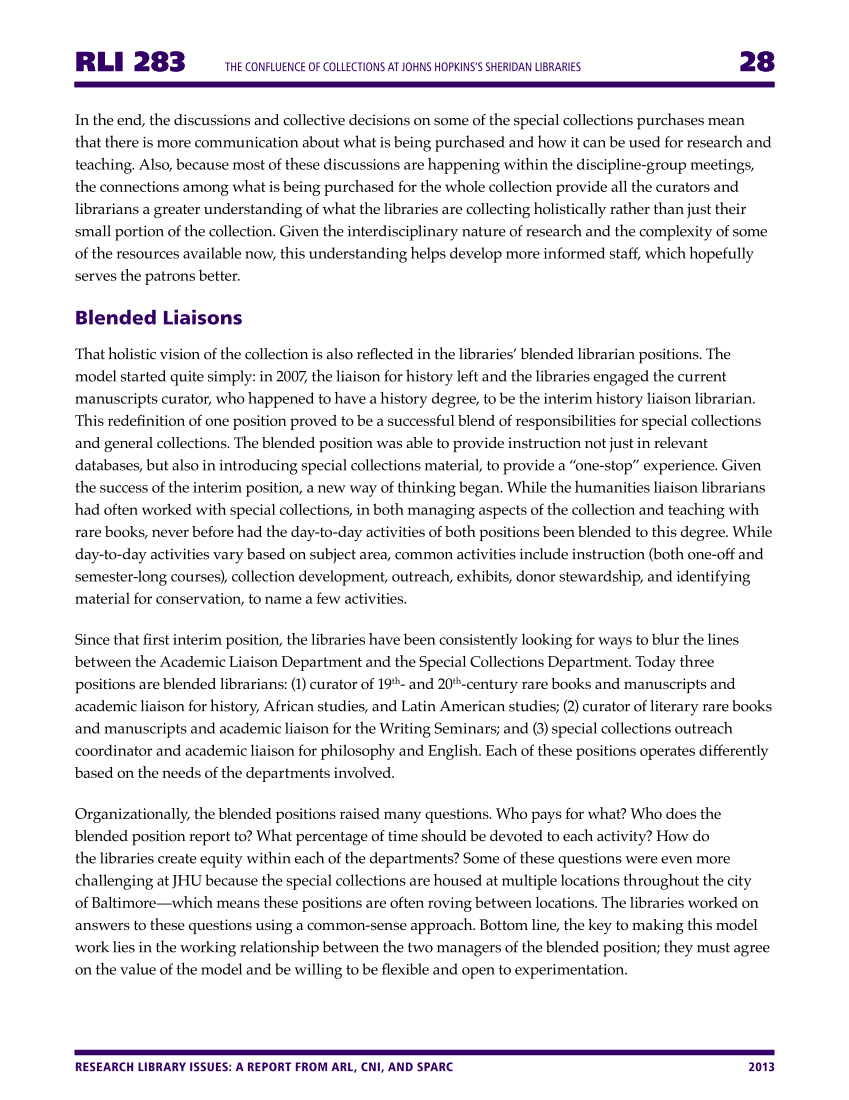RLI 283 The Confluence of Collections at Johns Hopkins’s Sheridan Libraries 28 RESEARCH LIBRARY ISSUES: A REPORT FROM ARL, CNI, AND SPARC 2013 In the end, the discussions and collective decisions on some of the special collections purchases mean that there is more communication about what is being purchased and how it can be used for research and teaching. Also, because most of these discussions are happening within the discipline-group meetings, the connections among what is being purchased for the whole collection provide all the curators and librarians a greater understanding of what the libraries are collecting holistically rather than just their small portion of the collection. Given the interdisciplinary nature of research and the complexity of some of the resources available now, this understanding helps develop more informed staff, which hopefully serves the patrons better. Blended Liaisons That holistic vision of the collection is also reflected in the libraries’ blended librarian positions. The model started quite simply: in 2007, the liaison for history left and the libraries engaged the current manuscripts curator, who happened to have a history degree, to be the interim history liaison librarian. This redefinition of one position proved to be a successful blend of responsibilities for special collections and general collections. The blended position was able to provide instruction not just in relevant databases, but also in introducing special collections material, to provide a “one-stop” experience. Given the success of the interim position, a new way of thinking began. While the humanities liaison librarians had often worked with special collections, in both managing aspects of the collection and teaching with rare books, never before had the day-to-day activities of both positions been blended to this degree. While day-to-day activities vary based on subject area, common activities include instruction (both one-off and semester-long courses), collection development, outreach, exhibits, donor stewardship, and identifying material for conservation, to name a few activities. Since that first interim position, the libraries have been consistently looking for ways to blur the lines between the Academic Liaison Department and the Special Collections Department. Today three positions are blended librarians: (1) curator of 19th- and 20th-century rare books and manuscripts and academic liaison for history, African studies, and Latin American studies (2) curator of literary rare books and manuscripts and academic liaison for the Writing Seminars and (3) special collections outreach coordinator and academic liaison for philosophy and English. Each of these positions operates differently based on the needs of the departments involved. Organizationally, the blended positions raised many questions. Who pays for what? Who does the blended position report to? What percentage of time should be devoted to each activity? How do the libraries create equity within each of the departments? Some of these questions were even more challenging at JHU because the special collections are housed at multiple locations throughout the city of Baltimore—which means these positions are often roving between locations. The libraries worked on answers to these questions using a common-sense approach. Bottom line, the key to making this model work lies in the working relationship between the two managers of the blended position they must agree on the value of the model and be willing to be flexible and open to experimentation.




































